The appearance of the check engine light on your dashboard can induce a momentary sense of panic for many drivers. While it’s essential to be informed about the proper steps to take, understanding what not to do is equally critical. Here are the key mistakes you should avoid when that ominous amber light illuminates.
Ignoring the Light
One of the most common, and potentially harmful, mistakes is simply ignoring the light. While the issue could be minor, like a loose gas cap, it could also be a sign of a more serious problem that can worsen over time. Address the light promptly to prevent potential bigger, and more expensive, issues down the line.
Panicking
While it’s important not to ignore the check engine light, it’s equally crucial not to panic. A lit check engine light doesn’t always signal a catastrophic problem. Panicking can lead to hasty decisions, so stay calm, assess the situation, and consult a professional.
Continuing to Drive Aggressively
If the check engine light turns on during a high-speed drive, towing, or when carrying a heavy load, it’s a good idea to ease off. Avoid pushing the car to its limits until the cause of the light has been identified and resolved.
Skipping the Professional Diagnosis
You might be tempted to guess the problem or use a basic OBD-II scanner to diagnose the issue yourself. While these scanners can provide a code indicating the issue, a professional mechanic will have the experience and tools to interpret the code correctly and suggest the best course of action.
Clearing the Code Without Resolving the Issue
With access to OBD-II scanners, some might be tempted to clear the code to turn off the check engine light. While this might temporarily turn off the light, it doesn’t address the underlying problem. Additionally, this makes it harder for professionals to diagnose the issue later, as they won’t have access to the stored codes.
Filling Up the Gas Tank Immediately
While a loose gas cap can trigger the check engine light, rushing to fill up your tank might not be the best immediate solution. Instead, make sure the gas cap is tight. If the light doesn’t turn off after several drive cycles, then the issue might be somewhere else.
Neglecting Other Warning Signs
A lit check engine light in conjunction with other symptoms (like strange noises, smoke, or a shortage in performance) can indicate a more serious issue. Don’t focus solely on the light—pay attention to your vehicle’s overall behavior.
Delaying a Visit to the Mechanic
Even if the car seems to be running good, it’s not advisable to put off a visit to the mechanic shop. Early detection can often lead to easier and less costly fixes.
Conclusion
The check engine light is an essential indicator of your car’s health. While it’s important to take proactive steps when it lights up, avoiding these common mistakes can save you time, money, and potential headaches down the road. Remember, when in doubt, consulting a professional is always the best approach.
Contact Us
Ready to get started with an Electronic Control Unit tailored to your needs? Fill out the form below, and we’ll help you find the perfect solution. It only takes a minute to complete, and our team will take it from there to ensure you get the expert support and service you need.
<!– wp:shortcode –>
